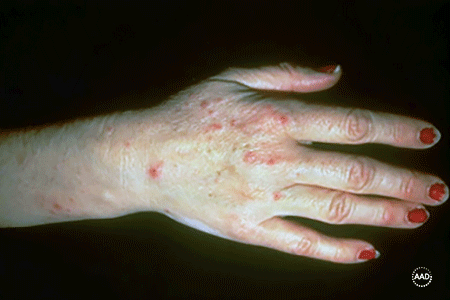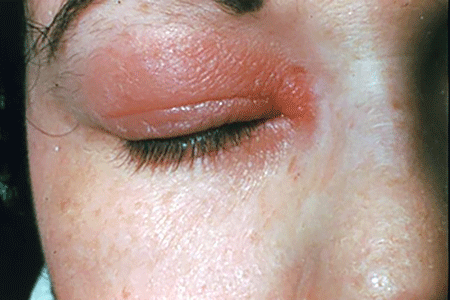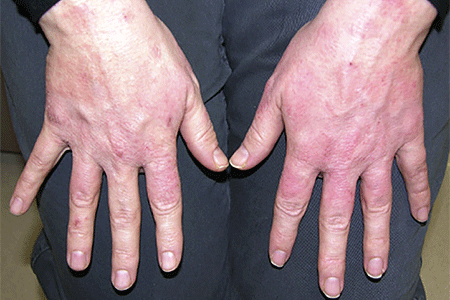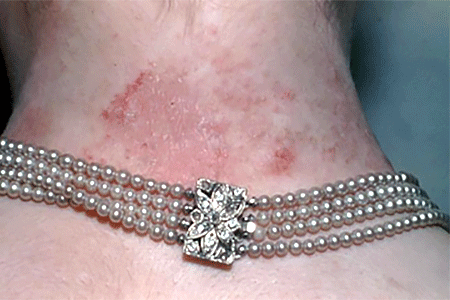Do you need a Dermatology appointment?
CONTACT DERMATITIS
 Almost everyone gets Contact Dermatitis, a type of Eczema, at least once in their lifetime. We get Contact Dermatitis when something that our skin touches causes a rash. Some rashes happen immediately. Most take time to appear.
Almost everyone gets Contact Dermatitis, a type of Eczema, at least once in their lifetime. We get Contact Dermatitis when something that our skin touches causes a rash. Some rashes happen immediately. Most take time to appear.Allergic Contact Dermatitis
Some people have an allergic skin reaction. You have had this type of contact dermatitis if you had a rash caused by:
- Poison ivy
- Nickel
- Makeup you applied once or few times
- Jewelry you wore for a long time without a reaction, such as a wedding ring
- Jewelry you wore for only a few hours or days
- Latex gloves
Irritant Contact Dermatitis
 This type is more common. It develops when something irritates the skin. With enough contact, most things will irritate our skin. A person diagnosed with any of the following has irritant contact dermatitis:
This type is more common. It develops when something irritates the skin. With enough contact, most things will irritate our skin. A person diagnosed with any of the following has irritant contact dermatitis:
- Diaper rash
- Acid burn
- Dry, cracked hands due to lots of contact with water
- Irritated skin around the mouth due to lip licking
When a toxic substance touches our skin, the skin is quickly irritated. You’ve had irritant contact dermatitis if your skin reacted to a toxic substance like:
- Battery acid
- Bleach
- Pepper spray
You can also develop irritant contact dermatitis when you have lots of contact with less irritating substances like:
- Water
- Foods
- Soap
People often develop irritant contact dermatitis at work. Beauticians, nurses, bartenders, and others who spend lots of time with wet hands get this. It often starts with dry, cracked hands. In time, the skin on their hands may begin to sting and burn. The skin becomes very tender. Sometimes, the skin itches and bleeds.
When a rash does not clear within a few weeks, you should see a dermatologist. When contact dermatitis develops, treatment is important. It can prevent the contact dermatitis from worsening and help your skin heal.

Contact dermatitis from frequent handwashing – You can reduce your risk of developing raw, irritated hands due to frequent handwashing by applying a fragrance-free hand cream after washing your hands and using a hand sanitizer with moisturizer.
How dermatologists diagnose Contact Dermatitis
To diagnose this common skin condition, dermatologists:
- Examine your skin, paying close attention to the rash.
- Ask about current and past health issues.
- Ask questions to help them determine what is causing the rash.
Finding the cause can require a bit of detective work. Your dermatologist may ask you questions about your work, free time, pets, and skin care products. Be sure to tell your dermatologist about all cosmetics you use. If you or a close family member uses a skin lightener, be sure to mention this, too.
If your dermatologist suspects that you have an allergy, patch testing may be recommended. This offers patients a safe and effective way to find out if your skin has developed an allergic reaction to anything.
What happens during patch testing?
 If patch testing is recommended, the following will happen:
If patch testing is recommended, the following will happen:
- Patches containing small amounts of substances to which you may be allergic will be applied to your skin, usually on your back.
- You keep the substances on your skin for a specific amount of time, usually 2 days.
- You return to your doctor’s office so that the doctor can check your skin for reactions.
- You may need to keep some patches on your skin for a longer time and see your doctor again in a few days.
To find out if the allergen is causing your rash, you will need to avoid that substance. For example, if the test shows that you have a nickel allergy, you may need to:
- Stop wearing jewelry and clothing (zippers, fasteners) that contains nickel.
- Cover your cell phone with a case to avoid touching the metal.
- Get a pair of eyeglasses made without nickel.
If your skin clears when you avoid the allergen, it is likely the cause of your rash.
How Dermatologists treat Contact Dermatitis
Treatment is the same for both types of contact dermatitis.
Avoid what is causing your rash. If avoiding the cause will be difficult, ask your dermatologist for help.
For example, if you are allergic to latex but must wear exam gloves, your dermatologist can recommend another type of glove that you can wear. If you must work outdoors where poison ivy grows, your dermatologist can recommend a protective barrier cream and clothing that can help.
Treat the rash. Once you can avoid the cause, your rash should clear. To relieve your symptoms, a dermatologist may recommend the following:
- Mild reaction: Antihistamine pills, moisturizer, and a corticosteroid that you can apply to your skin. Most patients apply the medicine twice a day for 1 week and once a day for 1 to 2 weeks. Oatmeal baths can relieve discomfort.
- Severe reaction: If you have a lot of swelling, your face swells, or the rash covers much of your body, you may need a strong medication. Your dermatologist may prescribe prednisone. It is important to take this medication exactly as directed to avoid another flare.Wet dressings can help soothe skin that has lots of oozing and crusting. If your dermatologist recommends wet dressings, you’ll receive instructions to help you make these at home.
If you have an infection, your dermatologist may prescribe an antibiotic.
Some patients need light therapy to calm their immune system. Your dermatologist may refer to this as phototherapy.
If you avoid what caused the rash, your skin will clear. Most people see clear skin within 1 to 3 weeks.
Clearing may take longer if poison ivy, poison oak, or poison sumac caused your rash. The first time you have an allergic reaction to one of these plants, the rash may linger for 6 weeks. If you get another rash, your skin should clear within 10 to 21 days.
Once your skin clears, you must continue to avoid what caused your rash.
If your rash does not clear, you should tell your dermatologist. You may need extra help.
Systemic Contact Dermatitis
Some people develop a rash even when they avoid touching the allergen. A rash can appear when the substance to which you have an allergy gets inside your body. The medical term for this condition is systemic contact dermatitis.
The allergen can get inside your body in different ways. You could:
- Eat food that contains the allergen
- Inhale or inject a medicine that contains the allergen
- Use birth control (IUD or spermicide) that contains the allergen
While rare, some people develop a rash because the fillings in their mouth contain mercury. They could only get rid of the rash when a dentist replaced their fillings with fillings that did not contain mercury.
Trying to find everything that contains the allergen can be a challenge. Your dermatologist may be able to help you create a list of things you need to avoid. The list often varies from region to region.
Tips for Self-Care
If you have contact dermatitis, the right skin care and prevention strategies can help heal your skin and prevent another itchy, painful rash. Here are the tips that dermatologists give their patients who have contact dermatitis.
- Avoid what’s causing your rash. To heal your skin and prevent another rash, you need to: 1) Know what’s causing your rash and 2) Avoid touching what causes it.For example, if you have an allergy to nickel, you need to know what often contains nickel and how to avoid it. You’ll find five tips that can help you avoid nickel at, Nickel allergy: How to avoid exposure and reduce symptoms.If you’re uncertain what’s causing your rash, a board-certified dermatologist can help. To find out how, see Contact dermatitis: Diagnosis and treatment.Until you see a dermatologist, you may be able to get an idea of what’s causing your rash by going to, Itchy rash could be contact dermatitis.
- Stop scratching. The rash can be itchy, but scratching tends to worsen the rash. Scratching can also lead to an infection.
- Relieve the itch with cool compresses, anti-itch medication, or oatmeal baths. To make a cool compress, run cold water over a clean towel, then apply the cool, damp towel to the area for 10-15 minutes a few times daily.Other ways to get relief are to apply an anti-itch medication that contains 1% hydrocortisone to your rash, slather calamine lotion on your itchy skin, or soak in a cool oatmeal bath. You can buy all these without a prescription.Calamine lotion and oatmeal baths can also help dry oozing skin.
- Apply a fragrance-free moisturizer or barrier repair cream after washing. This helps seal in moisture, which your skin needs. Of course, you want to test this product before applying it widely. When you find a product that won’t cause a skin reaction, apply the moisturizer or barrier repair cream while your skin is still damp after washing.To get the best results, it helps to apply your moisturizer (or barrier repair cream) throughout the day when your skin feels dry.
- Wash new clothes before you wear them. Washing new clothes helps to remove chemical residues and dyes that could cause a reaction.
Remember two key facts about contact dermatitis. If you suddenly develop a new rash, you can miss a likely cause, unless you know the following:
- The rash may not be caused by what’s touching your skin when you first see the rash. Something that touched your skin hours or days ago may be the cause. A rash from an antibiotic ointment may show up 4 days later.
- You can develop an allergic reaction to a product that you’ve used for years. This can happen for one of two reasons. If the product has been reformulated, it can contain different ingredients. The second reason is that you’ve developed a new allergic reaction.
How dermatologists help people who have contact dermatitis
Contact dermatitis can affect your life. A rash can come and go unexpectedly, making it difficult to do your job or enjoy life to the fullest. By teaming up with a dermatologist you can get treatment, often find out what causes your rash, and feel more comfortable.
If you have a rash that blisters, comes and goes, or causes discomfort, see a board-certified dermatologist.
